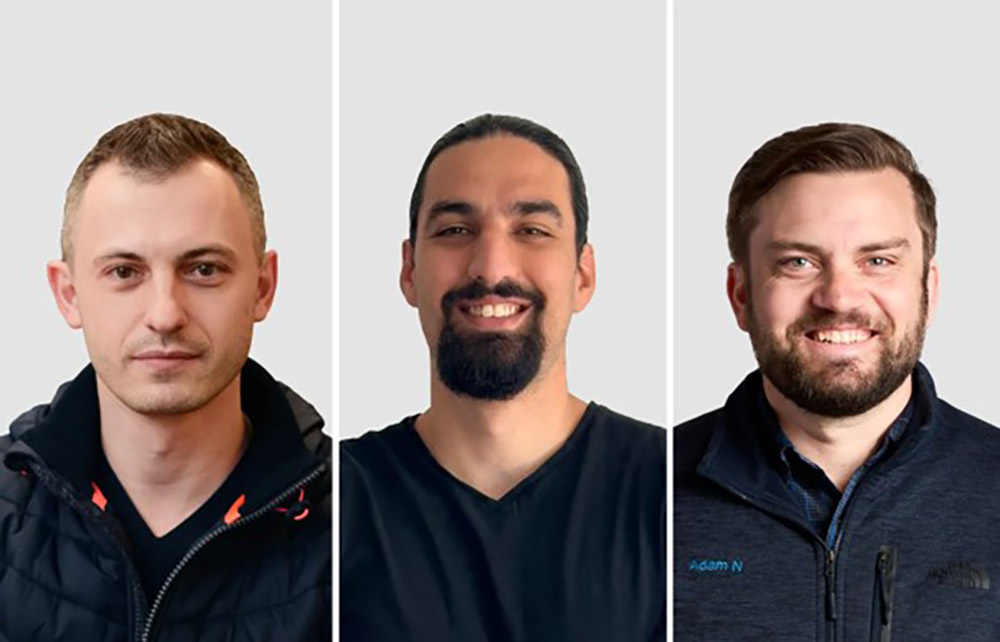
每當暢想AI具備類人能力的未來時,,空客前首席技術(shù)官保羅·埃雷蒙科首先想到的始終都是利用AI打造真實的機器。他對《財富》雜志說:“我想要一個能為我們建造星際飛船和戴森球的超級人工智能體,?!贝魃蚴强苹米髌分屑傧氲木扌徒Y(jié)構(gòu),能夠從恒星獲取能量,。
盡管這個夢想仍很遙遠,,但埃雷蒙科正在為此做基礎(chǔ)鋪墊工作。他與谷歌DeepMind前研究員亞歷克薩·戈爾迪奇,,以及空客創(chuàng)新中心Acubed前工程負責人亞當·內(nèi)格爾共同創(chuàng)立了P-1 AI公司,。該公司今日結(jié)束隱身模式,宣布獲得由激進創(chuàng)投領(lǐng)投的2300萬美元種子輪融資,。
P-1得名于托馬斯·約瑟夫·瑞安1977年的科幻小說《P-1的青春》(The Adolescence of P-1),,后者講述了一個有感情的人工智能體的故事。P-1正在開發(fā)名為Archie的AI工程代理,。該理念與Cognition AI的AI編程工具Devin類似,,旨在讓Archie融入并成為每個工程團隊的新成員,處理需求解釋,、初步設(shè)計概念生成以及法規(guī)合規(guī)性檢查等重復(fù)性耗時任務(wù),。
埃雷蒙科表示,令他感到驚訝的是,,目前還沒有人從事該領(lǐng)域的研究工作,,不過他很快明白了個中原因。與自動駕駛汽車和機器人一樣,,教導AI建造機器需要海量的訓練數(shù)據(jù),。他解釋說,關(guān)鍵在于通過建立電機,、管道,、軸等真實部件的虛擬模型,來模擬真實的工程系統(tǒng),。
戈爾迪奇指出,,這一點跟谷歌DeepMind利用圍棋訓練AlphaGo差不多,。AlphaGo是一個人工智能體,曾在圍棋這個超級復(fù)雜的策略棋盤游戲中戰(zhàn)勝了人類,。他對《財富》雜志說:“AlphaGo最初通過模仿人類棋手數(shù)據(jù)進行訓練,。”如今,,他將開始訓練和精校大語言模型和其他AI系統(tǒng),,使其能在數(shù)據(jù)中心冷卻或暖通系統(tǒng)等物理現(xiàn)象較為豐富的場景中理解和修改復(fù)雜工程設(shè)計。
他解釋說,,為超越ChatGPT這類大型語言模型所擁有的“高級自動補全”功能,,模型必須適用于執(zhí)行工程任務(wù)。因此,,AI需真正理解并遵從指令,。如果將基于物理模擬合成數(shù)據(jù)訓練的AI模型與能理解執(zhí)行該數(shù)據(jù)的AI模型相結(jié)合,那么就可以真正實現(xiàn)工程協(xié)助的自動化,。
埃雷蒙科表示,,P-1的投資者不僅關(guān)注公司務(wù)實的短期計劃,同時對公司的遠景尤為興奮,。他解釋說:“工程和AI領(lǐng)域的很多從業(yè)者從小便開始接觸科幻作品,。這些科幻作品都曾提及,未來將出現(xiàn)能夠建造星際飛船的超級人工智能體,?!?/p>
Autodesk、西門子和IBM等巨頭正在探索AI的工程應(yīng)用,,但它們既沒有創(chuàng)造新型的通用工程AI助手,,也沒有去探究上述用AI制造機器的宏大愿景。
不過,,埃雷蒙科和戈爾迪奇堅稱,,他們所走的這條路徑非常現(xiàn)實,,而且將專注地走下去,,它并不是一個沒有期限的純研究類項目。埃雷蒙科說:“它不會成為那種長達十年,、難以實現(xiàn)的項目,,而是一個非常務(wù)實的執(zhí)行和上市路徑?!保ㄘ敻恢形木W(wǎng))
譯者:馮豐
審校:夏林
每當暢想AI具備類人能力的未來時,,空客前首席技術(shù)官保羅·埃雷蒙科首先想到的始終都是利用AI打造真實的機器。他對《財富》雜志說:“我想要一個能為我們建造星際飛船和戴森球的超級人工智能體,?!贝魃蚴强苹米髌分屑傧氲木扌徒Y(jié)構(gòu),能夠從恒星獲取能量,。
盡管這個夢想仍很遙遠,,但埃雷蒙科正在為此做基礎(chǔ)鋪墊工作。他與谷歌DeepMind前研究員亞歷克薩·戈爾迪奇,,以及空客創(chuàng)新中心Acubed前工程負責人亞當·內(nèi)格爾共同創(chuàng)立了P-1 AI公司,。該公司今日結(jié)束隱身模式,宣布獲得由激進創(chuàng)投領(lǐng)投的2300萬美元種子輪融資,。
P-1得名于托馬斯·約瑟夫·瑞安1977年的科幻小說《P-1的青春》(The Adolescence of P-1),,后者講述了一個有感情的人工智能體的故事。P-1正在開發(fā)名為Archie的AI工程代理,。該理念與Cognition AI的AI編程工具Devin類似,,旨在讓Archie融入并成為每個工程團隊的新成員,處理需求解釋,、初步設(shè)計概念生成以及法規(guī)合規(guī)性檢查等重復(fù)性耗時任務(wù),。
埃雷蒙科表示,令他感到驚訝的是,,目前還沒有人從事該領(lǐng)域的研究工作,,不過他很快明白了個中原因。與自動駕駛汽車和機器人一樣,,教導AI建造機器需要海量的訓練數(shù)據(jù),。他解釋說,關(guān)鍵在于通過建立電機,、管道,、軸等真實部件的虛擬模型,來模擬真實的工程系統(tǒng),。
戈爾迪奇指出,,這一點跟谷歌DeepMind利用圍棋訓練AlphaGo差不多。AlphaGo是一個人工智能體,,曾在圍棋這個超級復(fù)雜的策略棋盤游戲中戰(zhàn)勝了人類,。他對《財富》雜志說:“AlphaGo最初通過模仿人類棋手數(shù)據(jù)進行訓練?!比缃?,他將開始訓練和精校大語言模型和其他AI系統(tǒng),使其能在數(shù)據(jù)中心冷卻或暖通系統(tǒng)等物理現(xiàn)象較為豐富的場景中理解和修改復(fù)雜工程設(shè)計,。
他解釋說,,為超越ChatGPT這類大型語言模型所擁有的“高級自動補全”功能,模型必須適用于執(zhí)行工程任務(wù)。因此,,AI需真正理解并遵從指令,。如果將基于物理模擬合成數(shù)據(jù)訓練的AI模型與能理解執(zhí)行該數(shù)據(jù)的AI模型相結(jié)合,那么就可以真正實現(xiàn)工程協(xié)助的自動化,。
埃雷蒙科表示,,P-1的投資者不僅關(guān)注公司務(wù)實的短期計劃,同時對公司的遠景尤為興奮,。他解釋說:“工程和AI領(lǐng)域的很多從業(yè)者從小便開始接觸科幻作品,。這些科幻作品都曾提及,未來將出現(xiàn)能夠建造星際飛船的超級人工智能體,?!?/p>
Autodesk、西門子和IBM等巨頭正在探索AI的工程應(yīng)用,,但它們既沒有創(chuàng)造新型的通用工程AI助手,,也沒有去探究上述用AI制造機器的宏大愿景。
不過,,埃雷蒙科和戈爾迪奇堅稱,,他們所走的這條路徑非常現(xiàn)實,,而且將專注地走下去,,它并不是一個沒有期限的純研究類項目。埃雷蒙科說:“它不會成為那種長達十年,、難以實現(xiàn)的項目,,而是一個非常務(wù)實的執(zhí)行和上市路徑?!保ㄘ敻恢形木W(wǎng))
譯者:馮豐
審校:夏林
When dreaming of the day artificial intelligence achieves humanlike ability, former Airbus CTO Paul Eremenko says he’s always done so in the context of building real-world machines. “I want an AI superintelligence that can build us starships and Dyson spheres,” he told Fortune—the latter being a hypothetical sci-fi megastructure that would harness energy from a star.
While his dream is still a long way off, Eremenko is laying the groundwork. He has joined forces with former Google DeepMind researcher Aleksa Gordi? and Adam Nagel, an engineering leader previously at Acubed, Airbus’s innovation center. Together, they have founded P-1 AI, which emerged from stealth today with a $23 million seed round led by Radical Ventures.
P-1, named after The Adolescence of P-1, a 1977 science fiction novel by Thomas Joseph Ryan about a sentient AI, is developing an AI-powered engineering agent called Archie. Similar to other AI agents like the AI-coding Devin from Cognition AI, the idea is to embed Archie as a junior member of every engineering team—to handle repetitive but time-sucking tasks like interpreting requirements, generating early design concepts, and checking compliance with regulations.
Eremenko said he was surprised that no one was already working on this goal, but he quickly figured out why. Just like with self-driving cars and robots, teaching AI to build machines requires a tremendous amount of training data. The key, he explained, is simulating realistic engineering systems by building virtual models of real-world components, like motors, pipes, and shafts.
According to Gordi?, it’s similar to how Google DeepMind used games to help train AlphaGo, the AI that beat human champions at Go, a famously complex strategy board game. "AlphaGo was trained initially to mimic data from actual human players," he told Fortune. Now, he will be training and fine-tuning large language models (LLMs) and other AI systems to understand and modify complex engineering designs in physics-rich systems like data center cooling or HVAC systems.
To go beyond the "glorified auto-complete" capabilities of LLMs like ChatGPT, he explained, the models must be useful for engineering tasks. The AI, therefore, must actually understand commands and follow instructions. The powerful combination of AI models that are trained on synthetic data built on physics simulations and that can then understand and act on that data makes truly automated engineering assistance a reality.
P-1’s investors, said Eremenko, are interested in the startup’s more grounded short-term plans—but they are particularly excited about the future. "A lot of us in the engineering and AI world, we grew up on sci-fi, and the sci-fi promised us a superintelligence that’s going to build starships," he explained.
Large incumbents like Autodesk, Siemens, and IBM are working toward elements of using AI for engineering, but they are not creating a new class of generalist engineering AI assistants, nor are they going after the same grand vision of AI-built machines.
Yet Eremenko and Gordi? insist theirs is a very realistic and focused path, and it’s not purely a research project with an indefinite time frame. "We’re not going to be a 10-year moonshot," Eremenko said. "This is a very pragmatic rollout and path to market."






